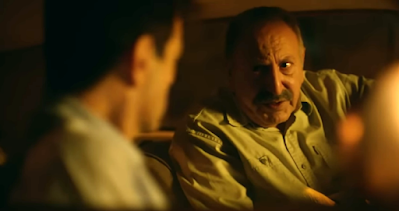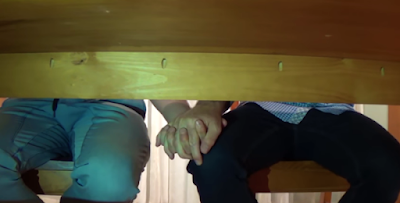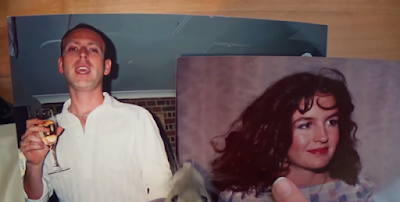one of your own kind
by Douglas Messerli
Jim Downey, Al Franken, Tom Davis, and Don Novello
and others (screenwriters), Dave Wilson (director), Pinklisting
/ 1985 [6.27 minutes] [TV-SNL sketch]
I suppose we have to give credit to Saturday
Night Live for taking on such a taboo subject in 1985. The episode,
comparing the current hysteria about AIDS and the gay spread of the disease
with McCarthyism, mocks those who in 1985 still kept their distance from gay
men for fear of infestation, thus forcing many gay men back into the closet.
Actually,
some of the incidents portrayed in the sketch were based on real events. As
Matthew Rodriguez, writing in the online magazine The Body noted, “The
sketch aired the fall after Rock Hudson died, after the tabloids ran several
stories claiming his Dynasty co-star Linda Evans got
In this
version of that hysteria, a famous actress Melinda Zoomont (played by Madonna)
is distressed since she thought they had cut the sex scene. The director, Art (Randy
Quaid) explains that since in this soap opera she’s going to have male star Clint’s
baby and he kidnaps her in later episodes, they had to reintroduce the scene
where they loll naked in a hot tub. Yet the actress is furious since,
proclaiming in her best Bette Davis imitation, “…I told you, I don’t do love
scenes with actors I don’t know,” meaning she won’t even associate with who are
not verifiably proven to be heterosexual and, so she was misinformed, therefore
safe from acquiring the HIV and AIDS.
The
director now explains the scene: they share a glass of wine, gaze into each
other’s eyes, you kiss passionately, you take off your clothes and you get into
the hot tub. He demands that the sound director turns on the sound for the hot
tub. “That’s a hundred and eight degrees in there, so you two should be quite
comfy.
Art
suddenly calls in the censor, since the director a question about the kissing
scene.
Jon
Lovitz, in his first SNL appearance, does various versions of tongue movement
to represent kissing that is most definitely off limits.
The
actors begin their scene, but suddenly a pulley falls loose and a rock comes
crashing into the small child’s pool next to them, all setting Lionel and his
character Clint into a screeching hysteria fit, which immediately leads Melinda
to declare: “Wait a moment. You’re gay!”
The director responds: “Clint, I admire your
guts, and I think you should know I’m gay too.”
Suddenly,
somewhat like the famous scene in the film Spartacus, where all his
soldiers claim to be the leader, so does the entire crew (which includes later
better-known figures such as Robert Downey, Jr. and Anthony Michael Hall) and
the makeup artist also admit they’re gay.
Clint
summarizes: “Living out this little charade, you know, was not a matter of
choice, but a matter of survival. [Looking hard at Melinda] But then I supposed
you wouldn’t know anything about that.”
Melinda
stands, claiming she does understand them, admitting that she’s an “intravenous
drug dealer.”
Art
wonders if they can now shoot the scene, but Clint storms off the set,
insisting that there’s no way that he will work with an “intravenous drug
dealer.”*
Critic Rodriguez found the sketch to be disarmingly edgy and progressive.”
While IndieWrite found it to be “something even more rare: the
mainstream media addressing AIDS in 1985 in a borderline sensitive manner.”
But
frankly, except for a couple of moments, I did not find it amusing, and found
Madonna’s acting to be something near to atrocious. Furthermore, all the gay
stereotypes are here: the effeminate high voiced hysteria, the closeted queen,
and the final self-righteous coming-out. Yes, the show should be lauded for
taking on the subject; but they could have done so much better if they only had
known a little more about the queer world and those who inhabit it. Rock Hudson
didn’t have to mime a straight man; that’s what as a gay man he looked like, a
gentle speaking baritone with a chiseled hunk’s body that drew in nearly every
woman who came near him, from the seasoned (even if she claimed to be totally
naïve) Elaine Stritch to my own mother. Even Howard, when I told him early in
our relationship that Hudson was gay, refused to believe it.
Although
this sketch, moreover, is focused on those who would shun and isolate primarily
gay men, it says nothing about all those gays and others who were actually
suffering from HIV or full AIDS, and spews none its ire at those many parents
and friends who had left their sons and daughters to die alone, without love. Let
alone does it talk about the real political ramifications of a US President and
his government appointees who refused to fund sufficient money for AIDS
research, many who were only too happy to ignore and punish the gay community
which most suffered the devastation of the disease.
By 1985
the scourge and its effect on the gay the community was well known, yet this
sketch makes no reference to it. Although someone like Jonathan Swift might
have put irony to good use to create a comic statement; however, by 1985 irony as
a literary tool unrecognizable my many people in the US, and the comic talents
of Downey, Franken, and others were not up to doing much else than poking fun
at those who misunderstood that the disease was spread not by sharing a hot
tube or kissing, but in making love, in sex itself—a subject still off the
radar in US TV offerings. In a sense, we have never recovered from the religious
right’s views of the 1950s with which this reminds us in its first frames.
Finally,
I’d like to ask, are we supposed to feel that there is some equivalency between
wanting to keep a distance from gay men and desiring to have nothing to do with
an intravenous drug dealer? Is Clint’s refusal to work with Melinda Zoomont connected,
in some manner, with her refusal to have anything to do with gay men? I see no
corollary, and find the joke almost offensive, particularly given the not-so-distant events I mention in the footnote below.
*Audiences of 1985 would also be aware of the 1981
killings of the so-called Wonderland gang, who dealt in cocaine and heroin, and
were shot to death in their Laurel Canyon, Los Angeles home for their robberies
of other drug dealers.
Los Angeles, July 11, 2025
Reprinted from My Queer Cinema blog (July
2025).


.png)
.png)














